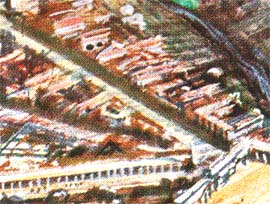 Contents -
Previous Article -
Next Article
Contents -
Previous Article -
Next Article
Roman engineers designed their roads to provide a solid surface on which to drive chariots and freight wagons or to move thousands of soldiers quickly. They had to be well drained so that rainwater did not build up and weaken them and they often had to cross wide stretches of wet or marshy ground without collapsing under the weight of an army legion and its heavy supply wagons. Roman roads were constructed with a foundation of rock so that they would not sink out of sight when the ground was waterlogged and would not wash away with the runoff from the spring thaw and rains.
To build a road, a work crew often consisting of soldiers or slaves under the supervision of soldiers would first dig two ditches.
Go to next article:
Go back to previous article: